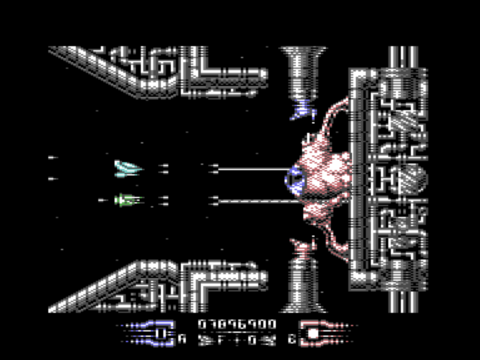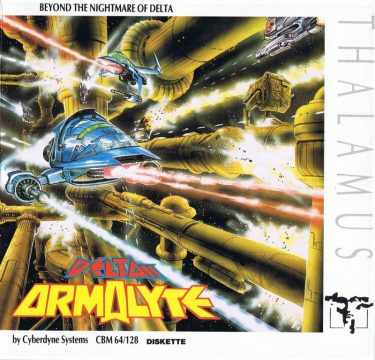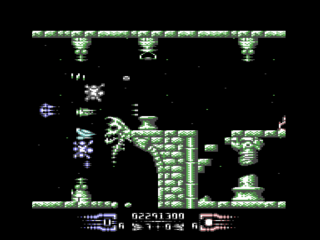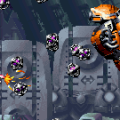Armalyte was considered a masterpiece when it was released in 1988, bringing the 8-bit Commodore 64 computer closer to the arcade experience. It reached number one in the European charts and the magazines of the time hailed it as the end-all of C64 shoot-em-ups. It all started when Dan Philips (main programming) became obsessed with Salamander in the arcades and was able to complete it on one 10-pence piece. He then convinced Robin Levy (graphics, attack waves, level design) to make their own horizontal shooter. Together with John Kemps (systems programming) they formed Cyberdyne systems, a reference to Dan’s favorite movie, The Terminator. The team wanted to do the C64 conversion of Salamander, and actually talked to Konami about it, but were disappointed to find out somebody else already got that job. They then decided to develop their own original shooter, Armalyte, which they eventually released through British publisher Thalamus Ltd.
The game’s backstory is only explained in the manual. In Armalyte you play the role of a fighter pilot hired by Armalyte Industries to reclaim a research outpost in the Delta region of space controlled by the H’Siffian Khanate. The outpost is strategically important because of the recent discovery of a power source of near-infinite potential. It is up to the player to retrieve the new technology.
Amalyte was developed in a period of nine months. There was no creative interference by Thalamus, and the team could spend a great deal of time on level design, enemy placements, general playtesting and balancing. Throughout the process, the code was optimized countless times to overcome the sprite, speed and memory limitations of the C64. Using clever programming, Dan Philips achieved more than 30 simultaneous on-screen sprites without flicker whilst maintaining a constant 50FPS. This was a huge accomplishment for the system and greatly contributed to the game’s positive reception. During development, Thamalus linked the team to Martin Walker to supply music and sound effects. The project started as Starburst, became Manowar and then Magnafox before it became Armalyte. The name Armalyte was picked from the lyrics of the track ‘Forgotten songs’ of the Marillion album Script for a Jester’s Tear and refers to the ArmaLite rifle. When the game was released, it was marketed as the sequel to Delta; an unrelated horizontal shooter developed by a different team that Thalamus had published one year prior.
Armalyte has eight levels which each have its own mid-boss and end-boss. The overall art style is visually stunning with graphics that stand out from other horizontal shooters on the C64. The levels include imposing metal structures, majestic rock formations, biomechanical constructions and columns, and temples with a strong neo-classical flavor. In earlier demos, Armalyte looked vastly different, and artist Robin Levy tested different visual styles before hitting on the final organic/metallic combination. Sprites are extremely well-animated, lending the game a high level of fluidity. Of special mention are the cool-looking bosses which are huge for the system and are all brought to life with some sort of cool-looking animation.
Sound-wise, Martin Walker’s title track ranks amongst the best tunes on the C64, and it is really worth booting up the game just to listen to this song. It is moody and mysterious with a memorable ‘out of this world’ vibe. The loading screens and outro music are equally fantastic and really fit the alien atmosphere of Armalyte. The in-game sound effects are very good too, the end-of-level baddies’ “machine hum” is especially nice. Most impressive is the sound of your superweapon cutting through anything, which has a nice thumping aural quality making it very satisfying to use. Given all this aural excellence, it is really a pity that Armalyte totally lacks in-game music which is probably the biggest fault of the game.
Armalyte features interesting and original weapon mechanics. Extra weapons appear in the shape of “Pods”, which change to different extras one after the other when shooting at them. There are the following extras: forwards shot, rear shot, vertical shot (both up and down directions), trident (stronger forwards shot), converge (two more shots to the forward-firing gun by diverting ammo from the rear gun), generator (increased battery recharge rate) and battery (extra storage cell to the ship’s battery, up to a maximum of four). If a pod is captured without having been converted to a power-up, then it makes the ship invulnerable for 5 seconds.
When there is a charge in the ship’s battery, the player can fire a ‘Super Weapon’, which is of great use. There are three types of Super Weapons, each of which is fired in the forward direction. Type A fires a long, sustained blast that can pass through scenery features which is helpful in only a few situations. Type B – releases a ‘cloud’ of small laser blasts around the spacecraft while Type C is similar to Type A, only the blast is much shorter and does not pass through scenery features. To toggle between the three types of Super Weapon the player must press the Commodore key on the computer keyboard.
The weapon system with its batteries and super shots is key for defeating bosses and adds a strategic dimension to the game. Death results in an instant respawn without losing your weapon upgrades, something which was a novelty at the time. However, at the start of the next level, the player’s ship loses all upgrades except for the batteries and generators. With a drone ship (always present in the single-player mode) hostile shots can be absorbed, but the drone itself has no damaging effect on colliding enemies. The drone ship can be made to freeze in its position by pressing the space bar on the keyboard, thus allowing the main ship to move independently. Knowing where to position the drone is important for defeating bosses. In the two-player game, the drone is replaced by a second ship (colored red and with a different design) fully controllable by the second player. Of interest is that the players can push each other around when colliding.
Except for the earlier-mentioned lack of in-game music, Armalyte has very few faults. Some people may find it frustrating to build an impressive arsenal only to lose it when starting a new level. Another nitpick is that the explosions of destroyed enemies move as they stay in the formation of the path they were in when destroyed. While this gives a cool impression of momentum, it can sometimes be challenging to see which enemies you’ve already killed.
After the success of Armalyte, Cyberdyne Systems announced that Armalyte 2 was being developed for the C64, with an intended 1990 release date. However, the moving away of key team member Robin Levy made it impossible to progress on the graphics, and the game was ultimately cancelled.
Already in 1988, the Amiga and Atari ST versions of Armalyte were announced but never made it to production. In 1991 Thalamus released Armalyte: The Final Run for the Amiga and Atari ST, developed by a different team (Arc Developments). This game was unrelated to the original Armalyte except for the sprite of the player’s ship and featured vastly different gameplay, graphics and sound. The game’s reception was lukewarm at best, and reviewers mainly critiqued the difficulty, which was felt to be unfairly hard, and the fact that it was nothing like the highly regarded C64 game. The Atari ST version is a watered-down version of the Amiga game with less smooth scrolling, fewer colors and weaker sound.
At one point a Game Boy Advance version of Armalyte was in the works but ultimately was never released. What does exist is a playable demo of Armalyte for the ZX Spectrum, which appeared on the cover tape of Your Sinclair Issue 65 in 1991 and only contains the first level. Although it looks quite well for the system, everything moves much slower than in the original game. This version never saw a full release although it was already previewed and advertised in magazines in 1988.
In 2009 Psytronik Software released Armalyte Competition Edition for the C64 featuring selectable levels and adjustable bullet speeds. A remake of Armalyte for the PC platform was published by Psytronik Software in 2012. The remake features the same gameplay and level layouts, but new graphics, animation, music and sound effects. This version was done by a different team although Dan Philips and Robin Levy are mentioned in the credits as “consultants”. The remake is a bit easier than the original and was received positively in the retro gaming community, although some considered the background graphics too clean.
It is easy to understand why so Armalyte is so well-remembered. It is amongst the most polished games that the C64 had. It’s a real technical tour de force, possessing amazing graphics, sprite animation, great sound effects, smooth scrolling, a great weapon system and addictive gameplay. In a way, Armalyte is even more enjoyable to play these days on an emulator or FPGA device as you can route your drone and superweapon keys to joystick buttons whilst including a designated auto-fire button, a luxury that was not possible back in the day.




